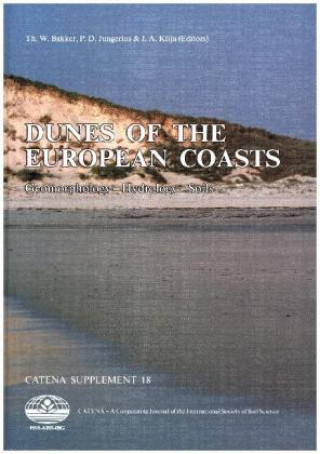
Kód: 15196203
Dunes of the European Coasts
Autor Th. W. Bakker, P. D. Jungerius, J. A. Klijn
With the integration of the European Community there is a growing awareness among scientists that landscapes which the participating countries have in common should be studied within a European framework. One of these landscapes i ... celý popis
- Jazyk:
 Angličtina
Angličtina - Vazba: Pevná
- Počet stran: 223
Nakladatelství: Schweizerbart'sche Verlagsbuchhandlung, 1990
- Více informací o knize

1880 Kč
Dostupnost:
50 % šance Máme informaci, že by titul mohl být dostupný. Na základě vaší objednávky se ho pokusíme do 6 týdnů zajistit.
Máme informaci, že by titul mohl být dostupný. Na základě vaší objednávky se ho pokusíme do 6 týdnů zajistit.Prohledáme celý svět
Mohlo by se vám také líbit
-

The Xmas Factor
345 Kč -

Ed Kashi: Abandoned Moments
1170 Kč -

Filvari Usta
306 Kč -

Magnus: la playa
268 Kč -

Konstruktion und Selbstorganisation
2234 Kč -

A fränkischa Fraa
212 Kč -

Estudios de derecho civil cubano
539 Kč
Dárkový poukaz: Radost zaručena
- Darujte poukaz v libovolné hodnotě a my se postaráme o zbytek.
- Poukaz se vztahuje na celou naši nabídku.
- Elektronický poukaz vytisknete z e-mailu a můžete ihned darovat.
- Platnost poukazu je 12 měsíců od data vystavení.
Informovat o naskladnění knihy
Zadejte do formuláře e-mailovou adresu a jakmile knihu naskladníme, zašleme vám o tom zprávu. Pohlídáme vše za vás.
Více informací o knize Dunes of the European Coasts
Nákupem získáte 188 bodů
 Anotace knihy
Anotace knihy
With the integration of the European Community there is a growing awareness among scientists that landscapes which the participating countries have in common should be studied within a European framework. One of these landscapes is formed by the coastal dunes found from northernmost Norway to the extreme south of Spain. Together with other coastal areas their economic and ecological importance is great. Moreover, man-induced or natural threats, such as large-scale construction, reclamation or sea level rise, ask for continual measures based on scientific insight. Awareness that the coastal zone merits communal concern has led to the recent foundation of two organizations: the European Union for Dune Conservation and Coastal Management (EUDC) and Eurocoast. Both are active in pooling knowledge of the coastal zone, organizing meetings, and promoting other related matters. This Supplement of CATENA should be seen as another effort to stimulate interest in one of the most striking aspects of the coastal zone: the dune landscape. The diversity of dune landscapes is astonishing. There is probably no other type of landscape in the world which in its two main elements, land form and land cover, shows so much variation over such short distances. The spectacular variety of form elements is above all a consequence of the combination of wind and sand, with the former representing a process capable of acting independent of gravity, and the latter constituing a substrate which deforms easily. The variety of land cover is related to plant-growth conditions which change drastically over short distances depending on differences in microclimate, groundwater regime, soil type and distance from the sea. Added to this there is the diversity caused by humans who intervene in a number of ways in their efforts to adapt the landscape to their needs. These needs spring from the many functions the dunes can have for society: recreation, building, nature conservation, protection against the sea, agriculture, water extraction, etc. Thus far, coastal dune landscapes have received little attention from the scientists who usually fill the contents of CATENA with contributions concerning "soil science, hydrology and geomorphology, focusing on geoecology and landscape evolution". It is mostly from botanists and vegetation ecologists that we have gained some understanding of dune ecosystems. They were among the first who realized the importance of environmental stress to the development of dune-building plants, thus drawing our attention to abiotic processes active in the dune ecosystem. The fact that few geomorphologists and pedologists have shown interest in the coastal dunes is amazing considering that dune landscapes form one of the few remaining natural regions not being located in remote and inaccessible corners of the world. Moreover, all sorts of geomorphological processes typical of widely different climates are active here at a truly exceptional speed. In this respect coastal dunes can be regarded as a genuine 'field laboratory'. The study of soil formation in dunes is much neglected even though pedological processes here are far more natural than are those found in agricultural regions with their man-made surface horizons. Those active in the dunes have noticed to their satisfaction that their studies are highly appre- dated by the managers of dune terrains, owing to the relevance that their findings have to nature conservation and other dune functions. Coastal dunes have scientific value to soil scientists, hydrologists and geomorphologists in at least two respects. First of all, there is a great need for a better understanding of the abiotic part of the ecosystems as a complement to the ecological research of biologists. Such studies should be carried out at three levels: those of individual plants (autecology), the entire vegetation complex (vegetation ecology), and the landscape (landscape ecology).
 Parametry knihy
Parametry knihy
1880 Kč
- Plný název: Dunes of the European Coasts
- Podnázev: Geomorphology - Hydrology - Soils
- Autor: Th. W. Bakker, P. D. Jungerius, J. A. Klijn
- Jazyk:
 Angličtina
Angličtina - Vazba: Pevná
- Počet stran: 223
- EAN: 9783510653591
- ID: 15196203
- Nakladatelství: Schweizerbart'sche Verlagsbuchhandlung
- Hmotnost: 690 g
- Rozměry: 240 × 170 × 16 mm
- Rok vydání: 1990
Oblíbené z jiného soudku
-

Dune
216 Kč -

Haunting Adeline
621 Kč -

Berserk Deluxe Volume 2
1092 Kč -

White Nights
89 Kč -

Powerless
268 Kč -

Atomic Habits
330 Kč -

Dune Messiah
228 Kč -

Berserk Deluxe Volume 3
1142 Kč -

One Day
221 Kč -

Berserk Deluxe Volume 1
1115 Kč -

Iron Flame
368 Kč -

Surrounded by Idiots
213 Kč -

Harry Potter and the Prisoner of Azkaban (Minalima Edition)
993 Kč -

Gravity Falls Journal 3
443 Kč -

Heaven Official's Blessing: Tian Guan Ci Fu (Novel) Vol. 1
420 Kč -

The Creative Act
568 Kč -

Dune
276 Kč -

Hunting Adeline
624 Kč -

A Little Life
290 Kč -

Children of Dune
230 Kč -

Heaven Official's Blessing: Tian Guan Ci Fu (Novel) Vol. 2
427 Kč -

Bungo Stray Dogs, Vol. 8 (light novel)
383 Kč -

Percy Jackson and the Olympians 5 Book Paperback Boxed Set
944 Kč -

Solo Leveling, Vol. 1
440 Kč -

The Prisoner's Throne
247 Kč -

Court of Thorns and Roses
268 Kč -

Cry Baby Coloring Book
276 Kč -

Fourth Wing
407 Kč -

Icebreaker
199 Kč -

Berserk Deluxe Volume 6
1089 Kč -

Avatar, the Last Airbender: The Kyoshi Novels (Box Set)
986 Kč -

The 48 Laws of Power
601 Kč -

House of Leaves
611 Kč -

Twisted Lies
213 Kč -

Dune Messiah
272 Kč -

No Longer Human
359 Kč -

48 Laws Of Power
331 Kč -

Twisted Games
213 Kč -

Caraval Paperback Boxed Set
902 Kč -

Solo Leveling, Vol. 2
468 Kč -

Open Circuits
907 Kč -

Berserk Deluxe Volume 5
1119 Kč -

Heaven Official's Blessing: Tian Guan Ci Fu (Novel) Vol. 3
436 Kč -

Berserk Deluxe Volume 4
1125 Kč -

Court of Mist and Fury
206 Kč -

SOLO LEVELING V08
436 Kč -

English File Upper Intermediate Multipack A (4th)
531 Kč -

CHAINSAW MAN V14
254 Kč -

Before the Coffee Gets Cold
184 Kč
Osobní odběr Praha, Brno a 12903 dalších
Copyright ©2008-24 nejlevnejsi-knihy.cz Všechna práva vyhrazenaSoukromíCookies


 Vrácení do měsíce
Vrácení do měsíce 571 999 099 (8-15.30h)
571 999 099 (8-15.30h)